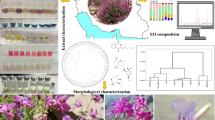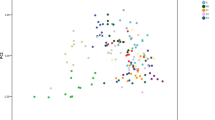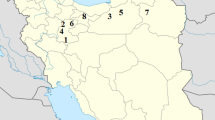Abstract
Satureja mutica Fisch is a highly aromatic species with interesting biological and pharmacological characteristics. This investigation was performed to evaluate the levels of inter- and intra-population variabilities of essential oil constituents and some agro-morphological characteristics of S. mutica in Iran. The essential oils of the aerial parts of plant have been analyzed by GC and GC/MS. High level of variability was found among the 58 individual plants of the seven studied populations. Coefficient of variation was the highest for essential oil content (CV = 52 %) among the populations. The essential oil content varied between 0.5 and 4.2 % (w/w). Thymol (6.5–74.6 %), carvacrol (0.9–70.4 %), borneol (0.1–10.9 %), p-cymene (0.30–14.2 %), and γ-terpinene (0.1–9.9 %) were identified as the major predominant constituents of essential oils for the studied individual plants. The clustering of individual plants based on the major oil components comprised three main groups, representing carvacrol/thymol/p-cymene, thymol/p-cymene/carvacrol, and carvacrol/borneol chemotypes. Among the studied agro-morphological traits, the highest levels of variability were observed for drug yield (CV = 99 %) and inflorescence length (CV = 55 %). Based on the higher essential oil content (4.2 %), drug yield (10.4 g plant−1), and plant height (45.9 cm), plant population from Keshanak region, because of its original habitat, is suggested as the most promising population for pharmaceutical purposes and mass production of essential oils. Thus, the variability recognized here might be considered for characterizing the large gene pool for breeding program.


Similar content being viewed by others
References
Adams RP (2007) Identification of essential oil components by gas chromatography/mass spectroscopy, 4th edn. Allured Publishing, Carol Stream
Agostini G, Agostini F, Atti-Serafini L, Echeverrigaray S (2006) Essential oil variability within and among populations of Cunila incisa Benth. Biochem Syst Ecol 34:802–808
British Pharmacopoeia (1993) Her majesty stationery office. HMSO, London
Dardioti A, Karousou R, Lanaras T, Kokkini S (2012) Diversity of Satureja pilosa subsp. origanita essential oils: a new Oregano from East Mediterranean. Biochem Syst Ecol 40:178–183
Delgado B, Fernandez PS, Palop A, Periago PM (2004) Effect of thymol and cymene to establish safe conditions related to Bacillus cereus vegetative cells through the use of frequency distributions. Food Microbiol 21:327–334
Gohari AR, Hadjiakhoondi A, Shafiee A, Ebrahimi ES, Mozaffarian VA (2005) Chemical composition of the essential oils of Satureja atropatana and Satureja mutica growing wild in Iran. J Essent Oil Res 17:17–18
Gulluce M, Sokmen M, Sahin F, Sokmen A, Adiguzel A, Ozer H (2004) Biological activities of the essential oil and methanolic extract of Micromeria fruticosa (L) Druce ssp serpyllifolia (Bieb) PH Davis plants from the eastern Anatolia region of Turkey. J Sci Food Agric 84:735–741
Hadian J, Nejad-Ebrahimi S, Salehi P (2010) Variability of morphological and phytochemical characteristics among Satureja hortensis L. accessions of Iran. Ind Crops Prod 32:62–69
Hadian J, Mirjalili MH, Kanani MR, Salehnia A, Ganjipoor P (2011) Phytochemical and morphological characterization of Satureja khuzistanica Jamzad populations from Iran. Chem Biodivers 8:902–915
Hadian J, Kavand S, Ahmadi J, Khadivi-Khub A (2014) Genotypic diversity and structure of Satureja mutica revealed by inter-simple sequence repeat markers. Biochem Syst Ecol 54:48–52
Herraiz-Penalver D, Angeles Cases M, Varela F, Navarrete P, Sanchez-Vioque R, Usano-Alemany J (2013) Chemical characterization of Lavandula latifolia Medik. essential oil from Spanish wild populations. Biochem Syst Ecol 46:59–68
Hornok L (1992) The cultivation and processing of medicinal plants. John Wiley, New York
Jamzad Z (2009) Thymus and Satureja species of Iran. Research Institute of Forests and Rangelands press, Tehran
Karousou R, Koureas DN, Kokkini S (2005) Essential oil composition is related to the natural habitats: Coridothymus capitatus and Satureja thymbra in NATURA 2000 sites of Crete. Phytochemistry 66:2668–2673
Lee LS, Brooks LO, Homer LE, Rossetto M, Henry RJ, Baverstock PR (2002) Geographic variation in the essential oils and morphology of natural populations of Melaleuca alternifolia (Myrtaceae). Biochem Syst Ecol 30:343–360
Munoz-Bertomeu J, Arrillaga I, Segura J (2007) Essential oil variation within and among natural populations of Lavandula latifolia and its relation to their ecological areas. Biochem Syst Ecol 35:479–488
Periago PM, Moezelaar R (2001) Combined effect of nisin and carvacrol at different pH and temperature levels on the viability of different strains of Bacillus cereus. Int J Food Microbiol 68:141–148
Rustaiyan A, Alireza Feizbakhsh A (2004) Comparison of the volatile oils of Satureja atropatana Bung. and Satureja mutica Fisch. et C.A. Mey. from Iran. J Essent Oil Res 16:594–596
Sefidkon F, Jamzad Z (2005) Chemical composition of the essential oil of three Iranian Satureja species (S. mutica, S. macrantha and S. intermedia). Food Chem 91:1–4
Sefidkon F, Jamzad Z, Mirza M (2004) Chemical variation in the essential oil of Satureja sahendica from Iran. Food Chem 88:325–328
Valero M, Giner MJ (2006) Effects of antimicrobial components of essential oils on growth of Bacillus cereus INRA L2104 in and the sensory qualities of carrot broth. Int J Food Microbiol 106:90–94
Vokou D, Kokkini S, Bessiere JM (1993) Geographic variation of Greek Oregano (Origanum vulgare ssp. hirtum) essential oils. Biochem Syst Ecol 21:287–295
Yanishlieva N, Marinova E, Gordon M, Raneva V (1999) Antioxidant activity and mechanism of action of thymol and carvacrol in two lipid systems. Food Chem 64:59–66
Zargari A (1990) Medicinal plants, vol 4. Tehran University Publications, Tehran, pp 42–45
Author information
Authors and Affiliations
Corresponding author
Rights and permissions
About this article
Cite this article
Karimi, E., Ghasemnezhad, A., Hadian, J. et al. Assessment of essential oil constituents and main agro-morphological variability in Satureja mutica populations. Braz. J. Bot 39, 77–85 (2016). https://doi.org/10.1007/s40415-015-0215-1
Received:
Accepted:
Published:
Issue Date:
DOI: https://doi.org/10.1007/s40415-015-0215-1




